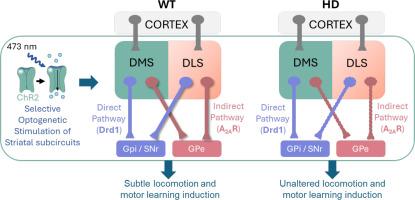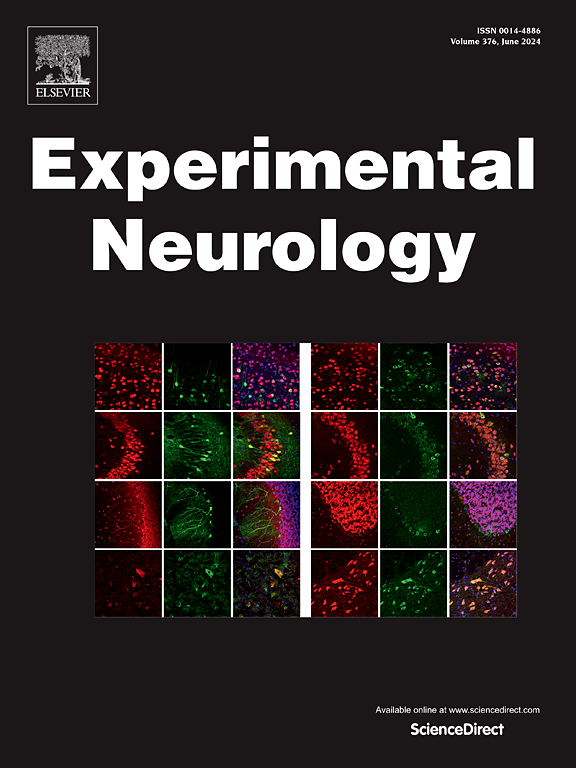Differential impact of optogenetic stimulation of direct and indirect pathways from dorsolateral and dorsomedial striatum on motor symptoms in Huntington's disease mice
IF 4.6
2区 医学
Q1 NEUROSCIENCES
引用次数: 0
Abstract
The alterations in the basal ganglia circuitry are core pathological hallmark in Huntington's Disease (HD) and traditionally linked to its sever motor symptoms. Recently it was shown that optogenetic stimulation of cortical afferences to the striatum is able to reverse motor symptoms in HD mice. However, the specific contribution of the direct and indirect striatal output pathways from the dorsolateral (DLS) and dorsomedial striatum (DMS) to the motor phenotype is still not clear. Here, we aim to uncover the contributions of these striatal subcircuits to motor control in wild type (WT) and HD mice by using the symptomatic R6/1 mice. We systematically evaluated locomotion, exploratory behavior, and motor learning effects of the selective optogenetic stimulation of D1 or A2A expressing neurons (direct and indirect pathway, respectively), in DLS or DMS. Bilateral optogenetic stimulation of the direct pathway from DLS and the indirect pathway from DMS resulted in subtle locomotor enhancements, while unaltering exploratory behavior. Additionally, bilateral stimulation of the indirect pathway from the DLS improved performance in the accelerated rotarod task, suggesting a role in motor learning. In contrast, in HD mice, stimulation of these pathways did not modulate any of these behaviors. Overall, this study highlights that selective stimulation of direct and indirect pathways from DLS and DMS have subtle impact in locomotion, exploratory activity or motor learning. The lack of responses in HD mice also suggests that strategies involving cortico-striatal circuits rather than striatal output circuits might be a better strategy for managing motor symptoms in movement disorders.

光遗传刺激背外侧和背内侧纹状体的直接和间接通路对亨廷顿病小鼠运动症状的不同影响
基底神经节回路的改变是亨廷顿舞蹈症(Huntington's Disease,HD)的核心病理特征,传统上与其严重的运动症状有关。最近的研究表明,光遗传刺激大脑皮层与纹状体的联系能够逆转 HD 小鼠的运动症状。然而,来自背外侧(DLS)和背内侧纹状体(DMS)的直接和间接纹状体输出通路对运动表型的具体贡献仍不清楚。在这里,我们利用有症状的 R6/1 小鼠,旨在揭示这些纹状体亚电路对野生型(WT)和 HD 小鼠运动控制的贡献。我们在 DLS 或 DMS 中系统地评估了选择性光遗传刺激 D1 或 A2A 表达神经元(分别为直接和间接通路)对运动、探索行为和运动学习的影响。对DLS的直接通路和DMS的间接通路进行双侧光遗传刺激会导致微妙的运动增强,同时不会改变探索行为。此外,对来自 DLS 的间接通路的双侧刺激提高了小鼠在加速旋转任务中的表现,这表明小鼠在运动学习中发挥了作用。与此相反,在 HD 小鼠中,刺激这些通路不会调节任何这些行为。总之,这项研究强调,选择性刺激来自 DLS 和 DMS 的直接和间接通路对运动、探索活动或运动学习有微妙的影响。HD小鼠缺乏反应也表明,涉及皮质-纹状体回路而非纹状体输出回路的策略可能是控制运动障碍患者运动症状的更好策略。
本文章由计算机程序翻译,如有差异,请以英文原文为准。
求助全文
约1分钟内获得全文
求助全文
来源期刊

Experimental Neurology
医学-神经科学
CiteScore
10.10
自引率
3.80%
发文量
258
审稿时长
42 days
期刊介绍:
Experimental Neurology, a Journal of Neuroscience Research, publishes original research in neuroscience with a particular emphasis on novel findings in neural development, regeneration, plasticity and transplantation. The journal has focused on research concerning basic mechanisms underlying neurological disorders.
 求助内容:
求助内容: 应助结果提醒方式:
应助结果提醒方式:


